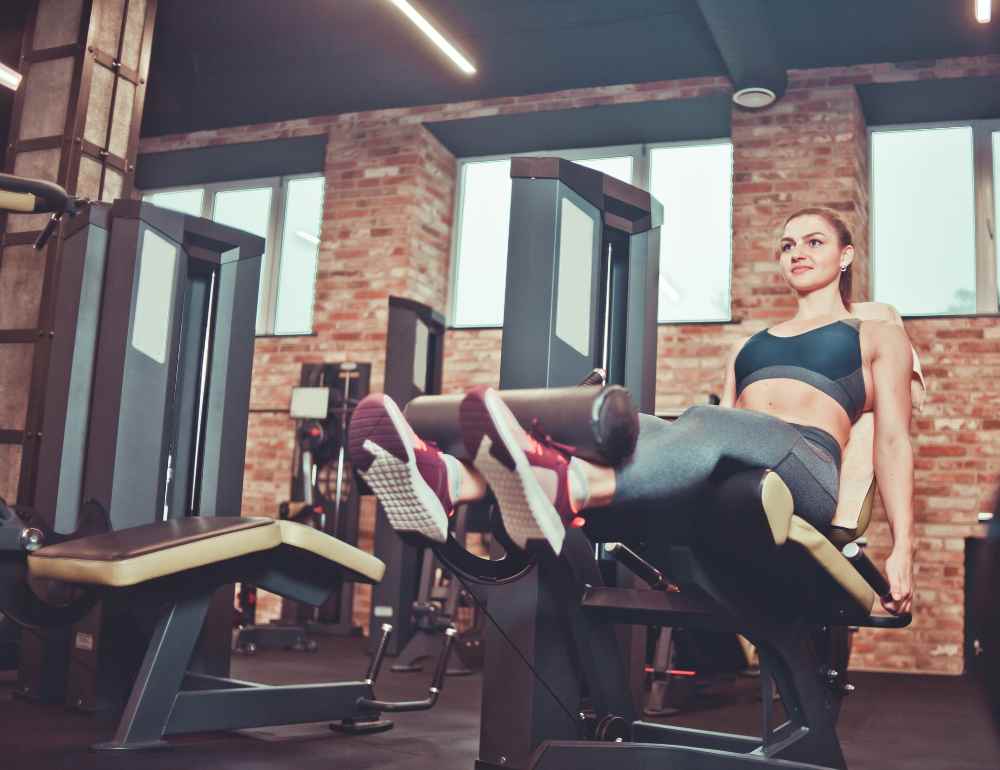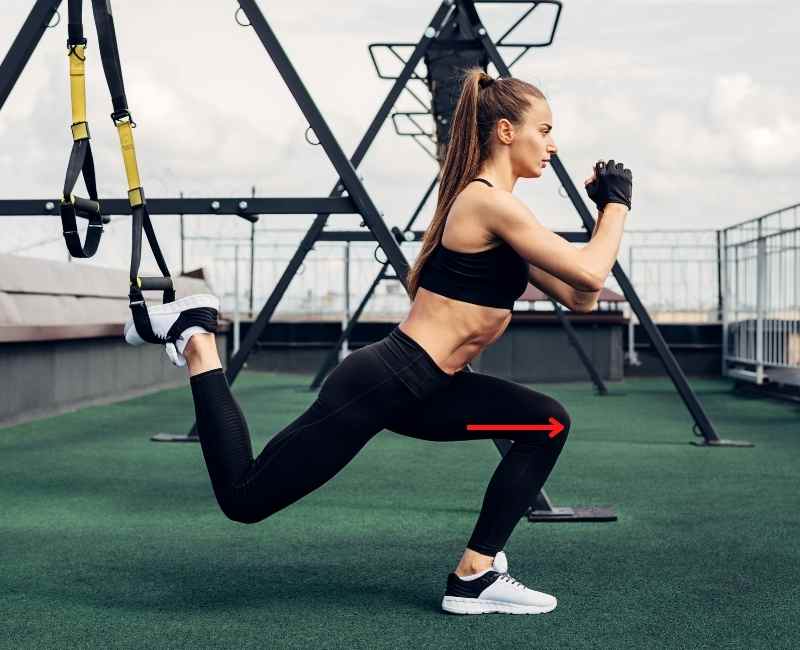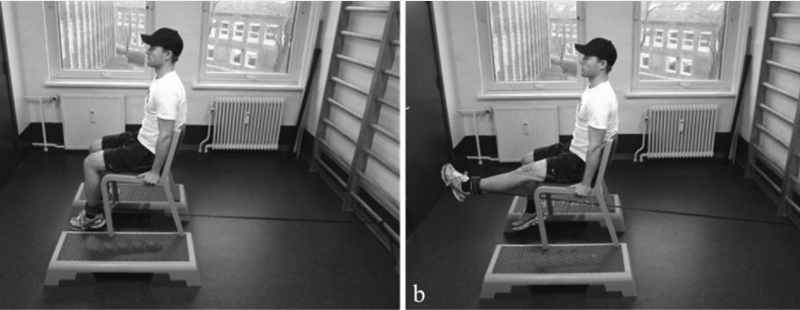Whether you are at the gym or home, here are my favorite leg extension machine alternatives you can use to strengthen your quadriceps.

The leg extension machine is one of the classic lower body machines for developing massive quads.
It’s simple, effective, and laser-focused on the muscles on the front of the leg, most specficially the four muscles that make up the quadriceps.
But, to do leg extensions requires a leg extension machine.
Which not all of us have at our disposal at home. Or, for that matter, at the gym.
In this article, we are going to look at the best leg extension alternatives that you can do at home, at the gym, on the road, or whenever you get the itch to get your quads stronger.
Let’s jump right in.
Leg Extension – Overview
The leg extension is one of my favorite exercises for building thick, strong leg muscles. It isolates the quads like just about no other.
Other benefits of the leg extension include an exceedingly short learning curve (sit in a chair, tuck leg under the roller, raise a foot to the sky = grow stronger quads).
It’s also an excellent exercise for people who are bouncing back after a knee injury and require a more fixed path of resistance that won’t over-excite tendons and ligaments around the knee.
The main muscles worked in the leg extension are the four muscles that make up the quadriceps:
- rectus femoris
- vastus lateralis
- vastus medialis
- vastus intermedius
So, when looking for an alternative to using the leg extension machine, you want a lower body exercise that is going to primarily target the quads, which are the largest muscles in the body.
The following exercises primarily target the quads. I’ll include technique points to ensure that you are getting the most quad activation as possible.
Let’s take a look at them now.
Leg Extension Alternatives for Both the Gym and Home
1. Squats
Bet you didn’t see that coming, did ya?
The squat reigns as king of the lower body exercises, not only for its utter functionality (who doesn’t want to be able to stand up better?), but also because it can be adapted in a multitude of ways to help you accomplish your specific goals in the gym.
The squat is generally quad-dominant to begin with, but we are going to tweak the exercise further to really get after those quads.
Here are some ways to do this:
- Allow the knees to go a little further ahead of the toes. The more your knees track out in front of your toes, the more quad engagement. Goes without saying that you should use this variation with caution if you have injured knees or unstable knees.
- Double the amount of time on the concentric phase (going up). Try a 1-1-3 count (one down, one second at the bottom, three seconds to go back up) when doing squats to lengthen the amount of time that the quads are under tension. The upward phase is where the quads are firing the most.
- Elevate your heels when squatting. Elevating the heels encourages the knees to track further forward. Use a squat wedge or try out a pair of squat shoes to elevate the heel so that you can increase the range of motion and depth in your squat.
One of the best reasons to use squats as a leg extension alternative is the countless ways you can do them.
If you don’t have a squat rack and barbell, no worries, grab your favorite resistance band and do banded squats. Or a kettlebell, dumbbell or medicine ball and do goblet squats.
2. Leg press
The leg press is another classic machine exercise that is excellent at targeting the quads.
Sliding into the leg press machine allows you to really isolate the quads, keep the movement on a fixed path (cutting out any energy expenditure due to stabilization as with squats), and there are even some foot placements on leg press that you can do to really target the quads.
A “normal” or slightly lowered foot position on the machine’s foot placement will fire up your quads at a higher rate compared to a higher foot placement (glutes).
See also: 6 Best Leg Press Alternatives for Monster Leg Muscles
Leg press, because it won’t drain your nervous system as fast as free weight compound exercises, can be used as a “finisher” at the end of your quad-focused leg days.
3. Bulgarian split squats
More squat action coming your way! The split squat, and particularly its popular cousin the Bulgarian split squat, have become very popular in recent years.
The reasons are straightforward: split squats are an isometric way to train your lower body, they are easier on the back compared to regular back squats, and they transfer well to athletic activities like running or jumping.
It’s also an awesome exercise that you can do at home or at the gym in lieu of a big lineup on the leg extension machine (or no leg machine whatsoever).
See also: How to Do Split Squats Like a Pro (Plus Benefits, Muscles Worked, and More)
We are going to take the regular split squat—where both feet are on the ground—and raise the non-working leg on an elevated surface.
The VASTUS MEDIALIS OBLIQUE (VMO) is one of the primary stabilizers of the knee. It’s the teardrop-shaped muscle at the bottom of your thigh. The VMO is one of the four quadriceps muscles.
A regular weight bench will do. The handle on a dangling TRX suspension strap. Anything that is about knee height.
The trick, as with our squat variations earlier, is to allow the knee to track a little bit ahead of the toes of your foot.

For more of a glute focus, you would want to “sit back” as you descend. To hammer the quads, lean forward a little bit and ensure the knee is getting out ahead of you
This may require some adjusting to get the foot placement right, but allowing the knee to track forward will really target the VMO.
4. Hack squats
The hack squat is another squat variation that is absolutely brutal, err, awesome at targeting the quadriceps.
The only downside, obviously, is that you are going to require a hack squat machine in order to do it.
(Check out this guide to the best hack squat machines if you are thinking of investing in one.)
Nevertheless, it’s an excellent leg extension alternative as it gives you some flexibility with foot placement.
The quadriceps muscles are knee extensors. Which means, the more your knee extends, the more activation you will see in the quads. More knee bend, more quad activation.
In the case of wanting to target the quads, a lower foot placement (again, like the leg press machine), will maximize quad development and recruitment.
Hack squats are one of my favorite lower body exercises as you can really play around with the angles and foot placement while also providing a fixed bar path (similar to the leg press machine).
See also: Leg Press vs Hack Squat: Pros, Cons and Differences for Monster Leg Muscles
For people easing into squats, hack squats provide some stability that provides confidence while also generating lots of activation in the quadriceps.
5. Smith Machine squats
Oh, I know—not another machine! But bear with me on this one, because if you are at the gym, and you’re looking at the line-up for the leg extension machine, you’re gonna thank me.
The Smith Machine gets a lot of attention, both good and bad, and is usually heated in either direction.
(If you want to read more about the eternal battle between Smith Machine vs Squat Racks, read this guide.)
Smith Machine squats have a lot of good things going for them, including increased stability and isolation of target muscles.
Particularly lifters who are coming back from injury (hello knees, looking at you), Smith machine squats are a good way to target the quadriceps.
The key is to line up your feet just in front of the bar to get more knee bend from the movement.
(By now, hopefully it’s really starting to sink in that you can modify just about any lower body exercise by creating more range in knee extension to really target your quads!)
6. Banded leg extensions
Another alternative to using a machine for leg extension is pulling out one of your trusty resistance bands.
Anchor the band, loop around the ankle, and straighten the leg from a seated position.
There is some work that has to be done in terms of getting the band of the ankle right. The band should be relatively horizontal, which would require anchoring it behind you, as opposed to the bottom of a chair (see below image for a visual example of what I am trying to describe).
Researchers [1] found that the banded leg extension elicited about 70% of the muscle activation in the quadriceps during the concentric phase compared to using a leg extension machine.

While not a perfect alternative, banded leg extensions are a great option for when you are on the road, want to get a quick workout at home, or simply want to avoid the machines at the gym and use a band instead.
It’s also a very popular exercise with physiotherapists who are helping people regain knee stability.
Banded leg extensions are also a unilateral exercise, ideal for when you are training around an injured leg or simply want to really focus on engaging your quads through the movement.
Leg Extension Alternatives — FAQs
How do you mimic leg extensions at home?
The best leg extension alternatives you can do at home are squats and elevated split squats. Both exercises can be done without weight, and with very minimal equipment.
In the case of elevated split squats, you can rest your non-working leg on a couch or chair, or anything else that is about the height of your knee.
With both exercises, aim for higher rep ranges. The quadriceps—the main muscles worked in the leg extension—are one of the largest muscles in the body and can handle a lot of work.
What makes a good leg extension alternative?
The cool thing about finding ways to train your quads without a leg extension machine is that you only need to find exercises that allow for lots of knee flexion.
The quadriceps are ultimately knee extensors, so any exercise that has a large range of motion in terms of how much you bend you knee will primarily target the quads. Modify your leg exercises to allow for more knee extension, and your quads will grow and get stronger!
The Bottom Line
At the end of the day, developing stronger quads, with or without a leg extension machine, is relatively straightforward.
And now that you’ve read this guide, you’ve got a deeper understanding of how to use other leg exercises to solicit lots of growth in the quads.
Remember, the quads are the largest muscles in the body, and can handle an elevated workload.
Don’t be afraid to go after them with ladder sets, higher rep ranges, and a variety of exercises that target the quads.
Choose the leg extension alternatives for you and your training, get to work, and quad on!
More Stuff Like This
5 Best Pre-Workout Stretches for Leg Day. A solid stretching routine before leg day reduces injury and maximizes your effort in the gym. Here are the best pre-workout leg stretches.
6 Best Leg Press Alternatives for Monster Leg Muscles. Looking to mix up your leg training? Here are the six best leg press alternatives for conquering leg day.